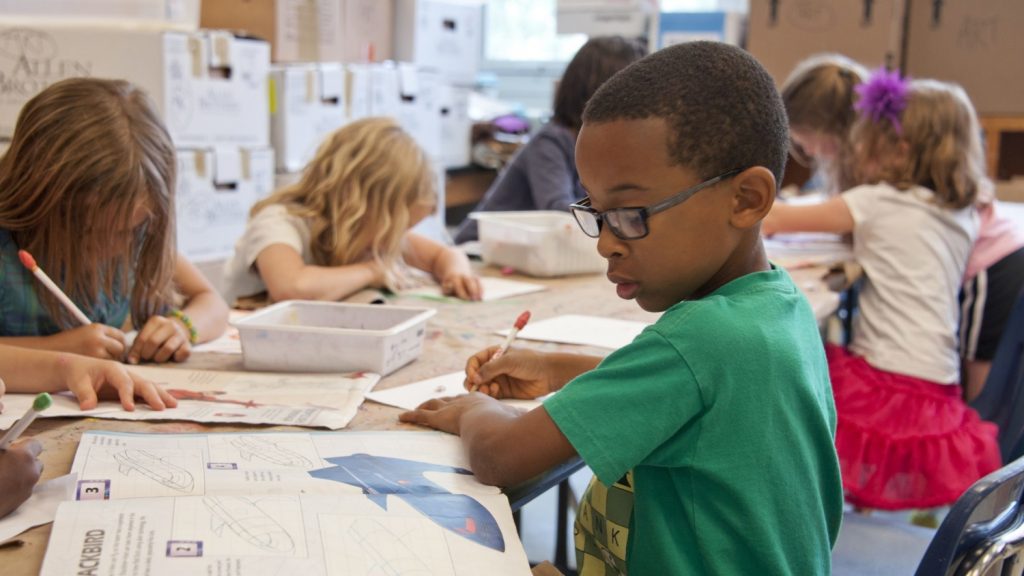AHS September Blog: Out-of-School Time Programs: A Critical Resource for Families

Written by: Sudha Sankar & Benjamin Pulgar-Guzman
In the United States, parents spend an average of 8 hours at work1, while children spend an average of 6.5 hours at school2. Not counting summers, mid-term holidays, and vacations, that leaves about 1.5 hours of care for school-going children outside the school day that families have to plan for. With children preparing to return to school each fall or leave when school ends each summer, parents scramble to manage schedules, meals, pick-ups and drop-offs, and …out-of-school time care.
What are out-of-school time programs?
Out-of-school time programs (OST) include after-school programs, before-school programs, track out sessions and summer programs. Many of these programs serve as an extension of the school day, creating opportunities for social skills, team work, and life skills development. They may also engage children in athletics and physical activity, and provide snacks or meals so children don’t go hungry. You might recognize some well known providers of out-of-school time care like the YMCA, Boys and Girls Clubs, or your city’s Department of Parks and Recreation. However, many small providers like local faith organizations and community centers are also critical resources bridging gaps in out-of-school time care.
Out-of-school time programs have a positive impact on children’s development.
Participation in high quality before and after school programs has been found to increase academic proficiency, school bonding, prosocial behavior, and decrease disruptive behavior3-5. Similarly, camp attendance has been associated with increased social awareness, grit, willingness to try new things, and better experiences at school the following year6. Engagement in out-of-school time programs has the potential to reduce summer learning loss and achievement gaps between students from low and high income families7. Mere access to adult supervision protects children from engagement in risky behaviors8.
Out-of-school time programs are family programs.
Out-of-school time programs don’t just benefit children. They also support family stability and workforce participation of parents. For many working adults, particularly women in the workforce and frontline workers, these programs are a necessary lifeline, ensuring that they don’t have to leave the workforce to give their children a safe space, adult supervision, and skill development.
There aren’t enough out-of-school time programs.
Unfortunately, for every child in an afterschool program in North Carolina, 3 are waiting to get in, a statistic that reflects the nationwide shortage of afterschool programs9. School-age children are underserved in this area with the majority of child care resources and programs dedicated to early childhood and preschool age children. Forty-two percent of parents surveyed for the aforementioned report said there simply aren’t enough programs. Anecdotally, we’ve heard parents tell us just how challenging and stressful it is to find and enroll their children in out-of-school time programs, with waitlists running several months or years long depending on where you live.
Why are out-of-school time programs so hard to access?
Parents and caregivers searching for high-quality out-of-school time programs for school age children face a wide array of barriers and inequalities10. There isn’t a comprehensive database of out-of-school time programs that parents can refer to. That, and complex enrollment procedures can be barriers to access. Even when programs are readily available, logistical challenges such as mismatch of program times with work schedules, lack of transportation to take children to and from out-of-school time programs, and high costs, pose challenges for families looking to enroll children in these programs8,11,12. These are the issues that Wake County Cooperative Extension and NCSU’s Department of Agricultural and Human Sciences are working to shine a light on with the Wake County Out-of-School Time Programs Study.

Wake County Out-of-School Time Programs Study
Parent & Caregiver Survey
We are asking parents and caregivers to complete a short 5-10 minute survey to understand whether families in Wake county have access to out-of-school time programs for their school-age children, which families need these programs but don’t have access to them, the types of programs they need, and what barriers they face in accessing these programs. Every parent who completes a survey will be able to enter a drawing to win a $50 gift card.
If you are a parent or caregiver to one or more school age children, click on the link below to participate in the WCOST Parent and Caregiver survey now and help us better meet families’ care needs across the County: https://go.ncsu.edu/ostsurvey
The survey can be taken in English and Spanish.
Provider Survey
We are also surveying out-of-school time program providers in Wake County to capture the availability, accessibility, types, targets, and activities of out-of-school time programs for school-age children. The information collected here will allow us to map out-of-school time resources in the county and provide a useful repository of information for families. We are also asking providers about the barriers they face, to identify ways to support OST providers and better serve families in our community.
If you know of an organization in your community that provides this critical service for children, please follow this link to let us know.
If you are a provider interested in participating in this survey, please contact Healthy Families Lab at healthyfamilieslab@ncsu.edu or share your information here: https://go.ncsu.edu/referostprovider.
References:
- American Time Use Survey, Bureau of Labor Statistics, 2022
- Schools and Staffing Survey, National Center for Education Statistics, 2007-08
- Lester, A. M., Chow, J. C., & Melton, T. N. (2020). Quality is Critical for Meaningful Synthesis of Afterschool Program Effects: A Systematic Review and Meta-analysis. Journal of youth and adolescence, 49(2), 369–382. https://doi.org/10.1007/s10964-019-01188-8.
- Shernoff, D. J. (2010). Engagement in after-school programs as a predictor of social competence and academic performance. American Journal of Community Psychology, 45(3-4), 325–337. https://doi.org/10.1007/s10464-010-9314-0
- Cavell, T. A., Elledge, L. C., Malcolm, K. T., Faith, M. A., & Hughes, J. N. (2009). Relationship quality and the mentoring of aggressive, high-risk children. Journal of clinical child and adolescent psychology : the official journal for the Society of Clinical Child and Adolescent Psychology, American Psychological Association, Division 53, 38(2), 185–198. https://doi.org/10.1080/15374410802698420
- National Camp Impact Study, American Camping Association, 2022.
- Fitzpatrick, Dan, and Jason Burns. 2019. “Single‐track Year‐round Education for Improving Academic Achievement in U.S. K‐12 Schools: Results of a Meta‐analysis.” Campbell Systematic Reviews 15(3). doi: 10.1002/cl2.1053.
- McCombs, Jennifer Sloan, Anamarie A. Whitaker, and Paul Youngmin Yoo, The Value of Out-of-School Time Programs. Santa Monica, CA: RAND Corporation, 2017. https://www.rand.org/pubs/perspectives/PE267.html.
- America After 3pm Report, Afterschool Alliance, 2020
- McNamara, A. R., Akiva, T., & Delale-O’Connor, L. (2020). Opportunity gaps in out-of-school learning: How structural and process features of programs relate to race and socioeconomic status. Applied Developmental Science, 24(4), 360-375.
- Sliwa, S. A., Calvert, H. G., Williams, H. P., & Turner, L. (2019). Prevalence and types of school‐based out‐of‐school time programs at elementary schools and implications for student nutrition and physical activity. Journal of School Health, 89(1), 48-58.
- Richmond, D., Hodge, C., & Sibthorp, J. (2023). Sending children to camp: An analysis of decision‐making by family income. Family Relations, 72(3), 1292-1310.
- Categories: